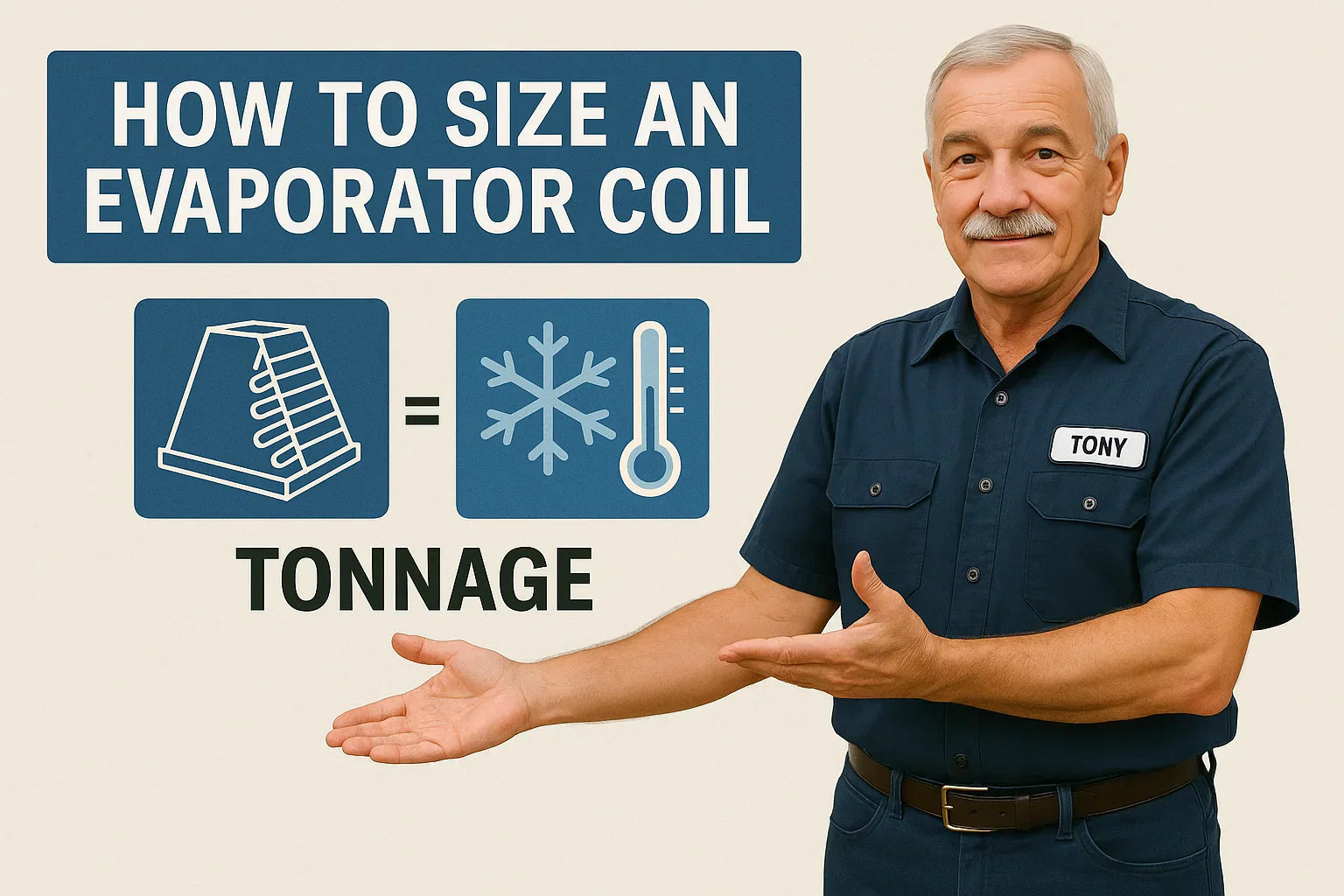Introduction: Size Isn’t Just About Square Footage
When it comes to choosing an evaporator coil, one of the most misunderstood (and most critical) factors is proper sizing. Many homeowners assume it’s as simple as matching coil tonnage to home size. But as Tony will explain, it’s a bit more complicated than that. Undersized or oversized coils can cause comfort issues, efficiency loss, and premature system failure.
In this comprehensive guide, we’ll break down:
-
What “tonnage” means
-
The risks of incorrect sizing
-
How pros calculate load requirements
-
Tools and tips for getting sizing right
What Does Tonnage Mean in HVAC?
-
Tonnage measures an air conditioner or heat pump’s cooling capacity.
-
1 ton = ability to remove 12,000 BTUs of heat per hour.
-
Common residential systems range from 1.5 tons to 5 tons.
Example:
-
A 3-ton system removes 36,000 BTUs of heat per hour.
Energy.gov - Cooling Capacity Explained
Why Evaporator Coil Sizing Matters So Much
If your coil is undersized:
-
The system can’t remove enough heat.
-
Air stays humid and uncomfortable.
-
Longer runtimes wear out components.
If your coil is oversized:
-
Short-cycling occurs (starts/stops too frequently).
-
Poor humidity control.
-
Reduced efficiency.
-
Shortened equipment lifespan.
Tony’s Tip:
"Bigger is not better with HVAC. It’s about balance, not brute force."
HVAC.com - Right-Sized HVAC Systems
How Professionals Determine Proper Coil Sizing
1. Manual J Load Calculation
-
Industry gold standard.
-
Accounts for:
-
Square footage
-
Ceiling height
-
Window type & exposure
-
Insulation levels
-
Occupancy
-
Appliance heat loads
-
Ductwork design
-
Local climate zone
-
2. Matching Coil to System Type
-
Coil must be compatible with:
-
SEER2 efficiency rating
-
Refrigerant type (R-410A, R-32)
-
Air handler or furnace configuration
-
3. Ductwork Capacity Check
-
CFM (Cubic Feet per Minute) airflow must match tonnage.
-
Undersized ducts choke airflow, regardless of coil size.
ACCA - Manual J Sizing Explained
Quick Sizing Rules of Thumb (For Initial Estimates)
| Home Size (sq. ft.) | Rough Tonnage |
|---|---|
| 600 - 900 | 1.5 tons |
| 901 - 1200 | 2 tons |
| 1201 - 1500 | 2.5 tons |
| 1501 - 1800 | 3 tons |
| 1801 - 2100 | 3.5 tons |
| 2101 - 2400 | 4 tons |
| 2401 - 3000 | 5 tons |
Important: These are starting points only. Climate, insulation, and home design strongly influence final load.
Evaporator Coil & Condenser Matching
-
Evaporator coil tonnage must match or slightly exceed condenser tonnage.
-
A slightly oversized coil (up to 1/2 ton larger) may improve dehumidification under certain conditions but requires careful system engineering.
-
Oversizing coils beyond this range leads to inefficiencies.
Matching Example:
-
3-ton condenser + 3-ton evaporator coil = ideal.
-
3-ton condenser + 3.5-ton coil = acceptable with correct expansion valve.
-
3-ton condenser + 4-ton coil = mismatch, poor performance.
HVAC School - Coil Matching Principles
Heat Pump vs. Air Conditioner Coil Sizing Differences
-
Both systems require matching tonnage.
-
Heat pumps require careful coil sizing for both cooling and heating modes.
-
Oversized coils can reduce winter heating efficiency.
Tony’s Note:
"Heat pumps add another layer of sizing complexity. Trust your tech to run full load calculations."
Coil Size vs. SEER Efficiency
-
Higher SEER2 systems often use larger surface-area coils to improve efficiency.
-
Bigger coil does NOT automatically mean higher capacity.
-
SEER efficiency and cooling capacity are related but distinct factors.
Real-World Sizing Mistakes to Avoid
Mistake 1: Relying on old system size
-
Homes change over time (windows, insulation upgrades, new appliances).
-
New load calculations should always be performed when replacing coils or systems.
Mistake 2: Going by square footage only
-
Ignores orientation, duct layout, ceiling height, window exposure.
Mistake 3: Oversizing "just in case"
-
Leads to humidity issues and short-cycling.
Mistake 4: Undersizing due to budget constraints
-
System struggles to maintain comfort.
Tony’s Take:
"Don’t cut corners here. It’s better to pay for a load calc than live with an uncomfortable house for 15 years."
Cost Differences by Coil Tonnage
| Tonnage | Coil Only Price Range |
| 1.5 ton | $400 - $800 |
| 2.0 ton | $500 - $900 |
| 3.0 ton | $600 - $1,200 |
| 4.0 ton | $800 - $1,500 |
| 5.0 ton | $1,000 - $2,000 |
-
Larger coils require more refrigerant charge.
-
Higher installation labor for larger units.
-
Oversized coils increase energy waste, offsetting upfront savings.
AC Coil Replacement Cost Guide
Questions to Ask Your Contractor About Coil Sizing
-
Will you perform a Manual J load calculation?
-
How will my ductwork impact sizing?
-
Is my existing air handler compatible with a new coil?
-
How will coil size affect humidity control?
-
What happens if I slightly oversize or undersize the coil?
Tony’s Final Advice on Sizing
"Sizing your evaporator coil isn’t the place to eyeball things or rely on guesses. A perfectly sized coil is like a perfectly tuned engine — smooth, efficient, and reliable. Always ask for load calculations, even if you trust your contractor. And don’t be afraid to get a second opinion if the numbers feel off."
Conclusion: Sizing Right Pays Off For Years
Getting evaporator coil sizing right ensures:
-
Lower energy bills
-
Improved humidity control
-
Consistent comfort
-
Longer equipment life
When you work with reputable suppliers like The Furnace Outlet, you gain access to properly matched, system-compatible evaporator coils to fit your exact load calculation needs.
In the next article we will know about: R-410A vs. R-32 Evaporator Coils: Are You Future-Proofing Your HVAC System?







